|
|
One
of the nice twists of history's perversity is that, while the
Duchamp Fountain exists in numerous replica versions, a
surviving example of the original type of urinal has proven impossible
to locate. If it exists at all, it is now an item of exquisite
rarity.
Kirk Varnedoe, Adam Gopnik,
High and Low: Modern Art and Popular Culture, MOMA Catalogue,
1990
|
|
Click
to enlarge
|
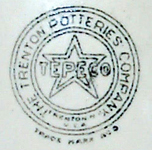 |
|
Illustration
35A.
|
Urinals
were purchased by Mott, Crane and other plumbing companies from
Trenton Potteries in Trenton, NJ.
The Bedfordshire urinals in the ASRL collection are all stamped
Trenton potteries.
|
Art historians William
Camfield and Kirk Varnedoe report that they strenuously searched the
historical record for urinal models that matched the geometry of Duchampís
urinal. My own research agrees with their conclusion -- that the closest
urinal to Duchampís is a model called the "Panama" or "Bedfordshire
with Lip." In the early 20th century, Mott, Crane and
other distributers purchased urinals from Trenton Potteries, Trenton,
NJ (a.k.a. "the sanitary pottery capital of the U.S."). Models
of urinals and other pottery products, such as toilets, were so basic
and so infrequently changed that only freelance workers were needed
to serve as modelers for the entire sanitary pottery industry. ASRL
owns three of the Bedfordshire urinals, and all are stamped, "Trenton
Potteries," NJ; see illustration 35A. The duplication of shape
among these urinals speaks both to the minimal variation that occurs
among urinals, and to the easy standardization of form resulting from
their mold making process.
Just as one hatrack
studio photo, found in the 1960's, provided a closer match (but no cigar)
to the Thonet historical model than any of Duchamp's other 2D or 3D
hatrack depictions, his urinal in two studio representations (34C and
34D) provide a close, but not exact, match to the Mott historical model
(see illustration 35B,C and D,E). Duchampís two studio photo urinals
are here compared to the Bedfordshire urinal with lip from the ASRL
collection, placed in a similar position. The general appearance is
similar among 35B,C and D,E. However, the "side ear-like"
brackets are larger and different, both from each other and from the
Mott model, as are the pipe connections at the urinalsí top and bottom.
Moreover, we have concluded from our analysis that one should be able
to see Duchampís "R. Mutt 1917" signature and date (and one cannot)
on a urinal when placed in both positions 35B and 35C, if the inscription
were indeed there.
|
click
each image to enlarge
|
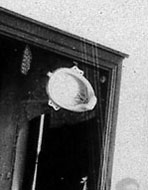 |
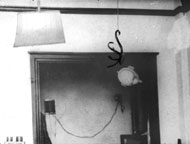 |
|
35B
|
35C
|
|
2
studio photos (35B, C) look similar
to the Mott/Crane Bedfordshire
with lip in 35D,E below;
Compare with detail images below
|
|
|
|
|
|
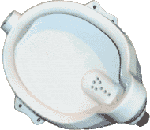 |
|
35B
detail
|
35C
detail
|
|
35D
|
|
|
|
|
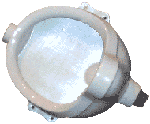 |
|
The
35B position would show the signature "R. Mutt 1917"
if it were there in the above studio photo -- as indicated by
our 3D computer model when placed in a similar angle.
|
The
35C position would show the "R. Mutt 1917" inscription
if it were there in the above studio photograph -- as indicated
by our 3D computer model placed in a similar angle.
|
|
35E
|
|
ASRL
Bedfordshire urinals placed in similar positions to urinals in
Duchamp's studio photos look easily similar, see 35B, 35C
|
However, when we examine
35B,C,D,E various attempts to place the Bedfordshire model in a position
to match the stieglitz photo 36A completely fail. Only when we composite
together the top part of the urinal from one photograph, the bottom
part from another and the drain holes and pipe hole from yet others
in different perspectives, does the urinal begin to look vaguely
like the stieglitz urinal 36A. Note that the bottom and top of the urinals
in 35B,C and 35D,E easily appear similar in size, scale and perspective
view, whereas, in 36A, the stieglitz original photograph appears to
be in one perspective view in the top half and in yet another camera
viewpoint in the bottom half where the pipe connection rests. Moreover,
when you look at our actual Urinal, 36D for example, the upper half
with the drain holes looks further away from us in the photo; whereas,
the bottom pipe hole part appears closer to us, in the foreground. Curiously,
no similar "near and far" positions are transmitted by the
forms in 36A, Duchamp's 1917 stieglitz photograph. In fact,in our Bedfordshire
urinal photos, 36B,C,D,E, the drain holes appear smaller, and therefore
further away, and the pipe hole reads larger and therefore closer to
us than in the 36A stieglitz photograph -- giving credence to my observation
that the stieglitz photograph, strangely, does not depict the significant
distance between the back of the urinal and the front (as clearly indicated
in 36B).
|
Click
each
image to enlarge
|
|
|
|
|
|
|
36A
|
36B
|
|
The
original stieglitz 1917 photo of Duchamp's urinal, unlike
Duchamp's two other studio photos, could not be easily approximated
when we photographed our Bedfordshire urinals. The Bedfordshire
is the only urinal model, circa 1917, that appears close
to, but not identical to, the original urinal depicted in
the stieglitz photo.
|
36
B,C,D,E are a series of photographs of our ASRL Bedfordshire
models that show our attempts
to reproduce a shape
similar
to the urinal
in the original
1917 stieglitz photo.
|
|
|
Click
to enlarge
|
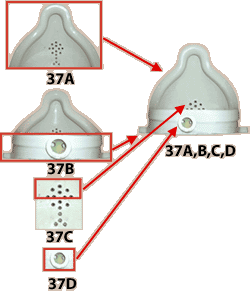 |
|
Illustration 37A,B,C,D.
|
|
We
combined four different photographs to create 37A,B,C,D -- as
our Bedfordshire urinal's drain holes, pipe hole, urinal top and
bottom parts could not be captured in one photograph with positions
that match the drain holes, pipe hole, and top and bottom parts
in the stieglitz photo (36A).
|
We provide the 2D
Interactive Presentation below to allow the spectator to experiment
with the cutting up and pasting together of different urinal photo parts.
There are 9 possible combinations. One combination matches the stieglitz
photo. Also, try placing the pipe in the middle as we suggest. One can
begin to see how pieces that do not originally go together can be moved
and will there appear to be better, or at least, equally correct in
their form, when in a new position -- especially if you had the ability
to fill in gaps with even more cut-out parts then we provide in this
presentation.
| |
|
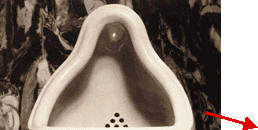 |
|
|
Partial
stieglitz photo found in 1980s is combined with part cut from
stieglitz 1917 photo (see part below)
|
|
 |
|
This bottom part is cut from the original
stieglitz photo, 1917
|
|
|
|
|
Click
each image
to enlarge
|
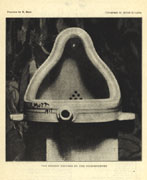 |
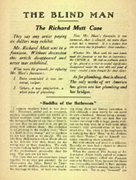 |
|
Illustration
38A.
|
Illustration
38B.
|
|
In
1917, Duchamp places, what I believe to be, a composited photograph,
in a journal titled The Blind Man
|
The
Blind Man No. 2: P.B.T., May 1917
|
More specifically,
this Interactive Presentation places together the bottom part, cut from
the entire Stieglitz original photograph (36A), with the mysterious
partial version (also printed from an original negative) as the top.
Perhaps, as in our coatrack example, where the working print probably
revealed Duchampís methodology for compositing his coatrack together
from a series of photos in different perspectives, perhaps this partial
photo of the urinal, printed and left as a complete image, represents
the smoking gun, also found to reveal similar evidence of being a photo
composite. For if we can, (1), easily create a likeness of the two 1917
photos of Duchamp urinals using the Bedfordshire 3D models and yet,
(2), run into difficulty when doing the same experiment by trying to
recreate the 1917 Stieglitz original urinal photo with the same Bedfordshire
3D model (the main difference being that the top part of the urinal,
as in the partial Stieglitz photo, lies in one perspective and the bottom
part in another), then perhaps the partial photo discloses itself as
a step that Duchamp used in a process of creating his final photo composite,
then aptly published in The Blind Man as he realized that we
would not readily see his alterations. (see illustrations 38A and B.)
|
Click
to enlarge
|
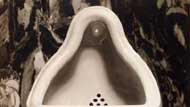 |
|
Illustration
39A.
|
Is the
Partial Stieglitz photo itself a photo composite?
|
Is this partial Stieglitz
photo itself, that we see in illustration 39A, also made of parts? And
is the complete version of the Stieglitz photo (38A) essentially a fusion
of yet more parts added to parts already composited in the top photo
of the partial version (39A)? Moreover, is the fusing of different perspectives
passing as one perspective in Duchamp's urinal, hatrack and coatrack,
the same "rehabilitated perspective" geometry that he claims
to have been using in his Large Glass?
|